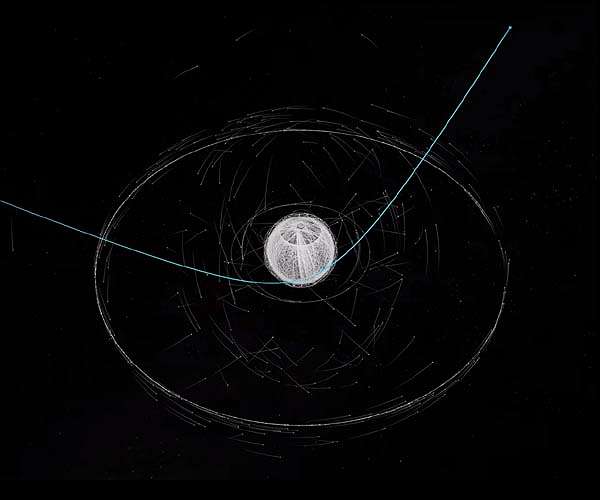
NASA’s Lucy to fly past thousands of objects for Earth gravity assist (Image Credit: Space Daily)
Mission engineers will track NASA’s Lucy spacecraft nonstop as it prepares to swoop near Earth on Oct. 16 to use this planet’s gravity to set itself on a course toward the Jupiter Trojan asteroids.
But they also will be closely tracking something else: more than 47,000 satellites, debris, and other objects circling our planet. A greater than 1-10,000 chance that Lucy will collide with one of these objects will require mission engineers to slightly adjust the spacecraft’s trajectory.
Although an adjustment is unlikely, and collisions are rare, the chances are increasing as the number of objects in Earth’s orbit grows, NASA experts say.
The International Space Station, for instance, has maneuvered out of the way of space debris 31 times since 1999, including three times since 2020.
“Low-Earth orbit is getting more crowded, so that has to be part of the consideration nowadays, especially for missions that fly low, like Lucy,” said Dr. Dolan Highsmith, chief engineer for the Conjunction Assessment Risk Analysis group at NASA’s Goddard Space Flight Center in Greenbelt, Maryland. The group determines the probabilities of collisions between NASA’s robotic spacecraft and Earth-orbiting objects. NASA’s Johnson Space Center in Houston does the same for crewed spacecraft, such as the space station.
Launched on Oct. 16, 2021, Lucy is on a 12-year-journey to study multiple Trojan asteroids up close. It’ll be the first spacecraft to visit these remnants from the early solar system, helping scientists hone their theories on how the planets formed 4.5 billion years ago and why they ended up in their current configuration.
But Lucy has a long way to go before it arrives at the Trojans in 2027. The upcoming gravity assist is one of three the spacecraft will rely on to catapult itself to its deep-space targets.
When Lucy comes nearest to Earth for its first gravity assist it will cruise 220 miles (350 km) above the surface. That’s lower than the altitude of the space station and low enough that the spacecraft will be visible with the naked eye from western Australia for a few minutes starting at 6:55 p.m. local time (10:55 UTC). On its way down, Lucy will fly through the most crowded layer of Earth’s orbit, which is monitored by the U.S. Space Force’s 18th Space Control Squadron. The squadron helps NASA identify close approaches.
Engineers began collision analysis for Lucy a week before the spacecraft’s Earth approach. Starting the process any earlier would render collision predictions futile, Highsmith said: “The further you’re predicting into the future, the more uncertain you are about where an object is going to be.”
Determining the positions of spacecraft, plus orbiting satellites and debris, is challenging, particularly when trying to anticipate the future. Largely that’s because the Sun plays a major role in pulling or pushing objects around, and future solar activity is hard to predict. For example, the Sun’s activity – how much plasma and radiation it shoots out – affects atmosphere density, and thus how much friction will tug on a spacecraft and slow it down.
So the closer the collision assessment is to the Earth flyby time, the better. NASA sends Lucy’s whereabouts to the Space Force squadron daily. If the squadron determines that Lucy could intersect with something, Highsmith’s group will calculate the probability of a collision and work with the mission team to move the spacecraft, if necessary.
“With such a high value mission, you really need to make sure that you have the capability, in case it’s a bad day, to get out of the way,” Highsmith said.
Lucy navigation engineers have two maneuver options ready in case the spacecraft needs to avoid an object. Both maneuvers require engine burns to speed up the spacecraft, which is traveling about 8 miles (12 km) per second. Each maneuver can move Lucy’s closest approach to Earth up by 2 seconds or 4 seconds, respectively.
“That’s enough to avoid any one thing that could be in the way,” said Kevin E. Berry, Lucy’s flight dynamics team lead from NASA Goddard.
Related Links
Lucy at SwRI
Lucy at NASA
Asteroid and Comet Mission News, Science and Technology
|
|
Tweet |
|
|
|
We need your help. The SpaceDaily news network continues to grow but revenues have never been harder to maintain. With the rise of Ad Blockers, and Facebook – our traditional revenue sources via quality network advertising continues to decline. And unlike so many other news sites, we don’t have a paywall – with those annoying usernames and passwords. Our news coverage takes time and effort to publish 365 days a year. If you find our news sites informative and useful then please consider becoming a regular supporter or for now make a one off contribution. |
||
|
SpaceDaily Monthly Supporter $5+ Billed Monthly |
SpaceDaily Contributor $5 Billed Once credit card or paypal |
|
NASA’s Lucy spacecraft prepares to swing by Earth
Boulder CO (SPX) Oct 17, 2022
On Oct. 16, at 7:04 a.m. EDT, NASA’s Lucy spacecraft, the first mission to the Jupiter Trojan asteroids, will skim the Earth’s atmosphere, passing a mere 220 miles (350 kilometers) above the surface. By sling-shotting past Earth on the first anniversary of its launch, Lucy will gain some of the orbital energy it needs to travel to this never-before-visited population of asteroids.
The Trojan asteroids are trapped in orbits around the Sun at the same distance as Jupiter, either far ahead of or behi … read more









